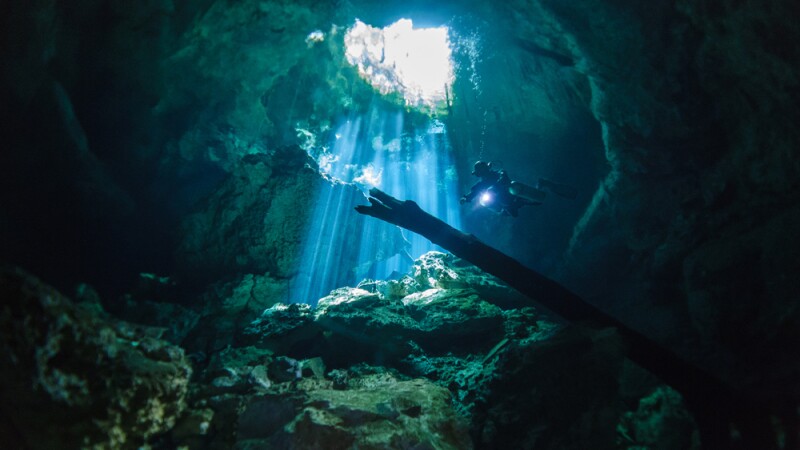“Let me tell you about giant cave, which is the biggest cave we have in Belize and one of the biggest caves in the world,” says Ben Popik, an amateur cave diver who moved to Ambergris Caye from Brooklyn eight years ago. “You enter this shaft and you go down this hole, which is maybe five or six feet in diameter, and you drop straight down 75 feet. At the bottom of this vertical tunnel, you do maybe 20 feet of army crawling and then it opens up into this massive room. It’s room after room and they’re all huge. They could be 150 feet wide, 80 feet tall or taller, and it’s just columns, stalactites, and every direction you look, there’s this other room you can go into. It’s an amazing underwater world.”
Underwater exploration has long fascinated adventurous types, and many scuba divers are drawn to this portion of the Caribbean partly because it’s chock-full of incredible geological formations and partly because of the treasures those formations hide. Recently, the team behind the Great Maya Aquifer Project discovered the world’s largest underwater cave off the coast of Tulum, Mexico. Inside, they found extinct fauna and relics from the ancient Mayans, who believed that caves and cenotes were sacred portals to the underworld.

A cave diver wearing sidemount air tanks explores Cenote Tajma-Ha in Mexico
Photo by Joana Villar/Shutterstock
Belize, in particular, is considered to be the region’s crown jewel. It is home to the Northern and Western hemispheres’ largest coral barrier reef, second in size only to Australia’s Great Barrier Reef. Also, Belize’s Great Blue Hole is often considered a bucket-list dive and for good reason. This incredible sinkhole is a national monument and one of the seven sites that make up the UNESCO World Heritage designated Belize Barrier Reef System. There, snorkelers can see the coral reefs, a variety of fish, and sharks, while scuba divers can get up close and personal with the eels, stingrays, and octopi that hide in the reefs and sand flats. But only cave divers can explore some of the country’s—and the planet’s—most incredible natural wonders.
Of course, diving in dark, enclosed environments filled with stalagmites and stalactites isn’t easy. Unlike SDI and PADI training, which only take a day or two, cave diving certification is a long and arduous process. Popik went through about nine months of training and completed six levels of certification before he could start cave diving. It’s one of the most dangerous sports in the world, and stories about the deaths of experienced divers scare plenty of people away. But Chip Petersen, owner of Belize Diving Services in Caye Caulker, insists it’s doable given the proper training. “Now, the people who die are people who are pushing their limits . . . and not following the rules. If you’re a trained cave diver and you’re not doing exploration, it’s—I can’t say safe—it’s not as dangerous as [what] you’ve read.” Belize Diving Services was founded in 1978, back when the area was underdeveloped and isolated, and Petersen, who now splits his time between Colorado and Caye Caulker, bought the dive shop in 2009. He and his wife met traveling and dived extensively together before deciding to settle in Belize. “We developed a list of several different things we wanted,” Petersen says of their search for a dive island to call home. Among those were an opportunity to contribute to the local economy and the freedom to develop aspects of the industry, including tech diving and cave diving. He was Popik’s instructor and taught him advanced decompression procedures, sidemount training, deep diving, intro to cave diving, and (finally) cave diving.
“A lot of things become important when you’re cave diving that aren’t important in open-water diving,” Popik explains. For cave diving, as he tells it, most of the training is experience-based and is meant to prepare you for a sport that’s more like floating in outer space than walking on land. You have to learn to control your buoyancy, tie lines, leave markers, and deal with possible emergencies. And unlike normal scuba diving, you have to wear two air tanks on your front instead of one on your back and carry two flashlights in case one goes out. “It became about fine-tuning [regular scuba] skills and taking on a lot of other skills,” Popik says. “So it was a lot but it’s definitely rewarding.”

Diving through narrow passages and tight spaces requires a separate skill set.
Photo by jimcatlinphotography.com/Shutterstock
I ask Popik if he would describe himself as an adrenaline junkie and he says no. “I’m not doing this because it’s dangerous. I’m doing it because of how unique it is. I love diving—it’s a big part of why I moved to Belize in the first place. I feel like cave exploration is the next level of that in a really exciting way.” Petersen seems to agree. He says that in Belize, the first 100 feet is the most difficult part because you have to squirm your way in there. “It’s some of the hardest cave diving in the world, but then once you get in there it gets more and more beautiful.”
>>Next: One Tiny Country Is Fighting to Save Its Endangered Reefs—for All of Us











